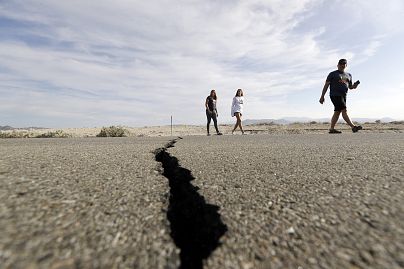"I don't want to frighten people," one expert said. "But I think it's important to be transparent. This is a real issue."
They're common across Los Angeles — older, low-slung apartment buildings that have a parking lot tucked underneath.
They're also potentially dangerous in a powerful earthquake.
In one of the region's most destructive temblors in recent history — the deadly 6.7 magnitude quake that struck the San Fernando Valley area in 1994 — dozens of people died, including 16 in an apartment collapse, said Kenneth O'Dell, president of the Structural Engineers Association of Southern California.
He is using the pair of earthquakes that rocked Southern California last week to remind officials and policymakers to address the massive number of "soft-story" buildings across the region, of which he says there are tens of thousands in Los Angeles county.
"I don't want to frighten people," O'Dell told NBC News. "But I think it's important to be transparent. This is a real issue."
O'Dell estimated that half a million people likely call these structures home.
That estimate is drawn, in part, on a recent survey done in the city of Los Angeles that found roughly 12,000 soft-story structures built before 1978. Extrapolating out across a county that has dozens of cities and a population of more than 10 million, O'Dell said the area could easily have double that number.
Such buildings were a popular way in California's booming post-war period to creatively combine housing and parking, he said. But this design — forged in an era before many leaders and engineers gave much thought to earthquake-conscious construction — also makes them vulnerable to the region's persistent seismic activity.
Parking lot support posts that carry a building's weight were often designed to maximize car space — not to withstand the side-to-side shifting of an earthquake.
"The posts are too weak," O'Dell said. "They buckle."
The posts in old buildings tend to have columns the size of a parking lot paint stripe — somewhere between three and five inches in diameter, O'Dell said. Newer columns can be roughly 10 inches.
Another important difference between old and new construction is the addition of a beam between columns. This creates a frame that helps accommodate a quake's seismic energy, he said.
A powerful temblor could either collapse these old buildings or shift them so dramatically that they're uninhabitable, he said.
Some Southern California cities have begun adopting ordinances that require owners to retrofit their soft-story structures. In 2016, the city of Los Angeles began enforcing an ordinance that gave owners seven years to retrofit their properties.
Santa Monica passed a similar ordinance in 2017, and in Pasadena, a seismic retrofit law went into effect last month. In Beverly Hills, senior engineer Arlen Eskandari said the city sent out notices of compliance about a recently passed law to building owners last week. And in West Hollywood, where an ordinance went into effect last year, the building and safety manager said that roughly 10%of the city's 738 soft-story retrofit plans are being drawn up, reviewed or implemented.
"That's pretty significant," said the manager, Ben Galan.
O'Dell said that some property owners have acted without the mandate of local officials. And he commended the cities that have begun fixing outdated building design through legislation.
But he pointed to a 2016 survey of six Southern California counties that found only seven of 191 cities were either considering passing or had already passed retrofitting laws. Six were in Los Angeles County. The other was in Ventura.
"Too few of the cities in Southern California have taken the initiative to move this forward," he said.












